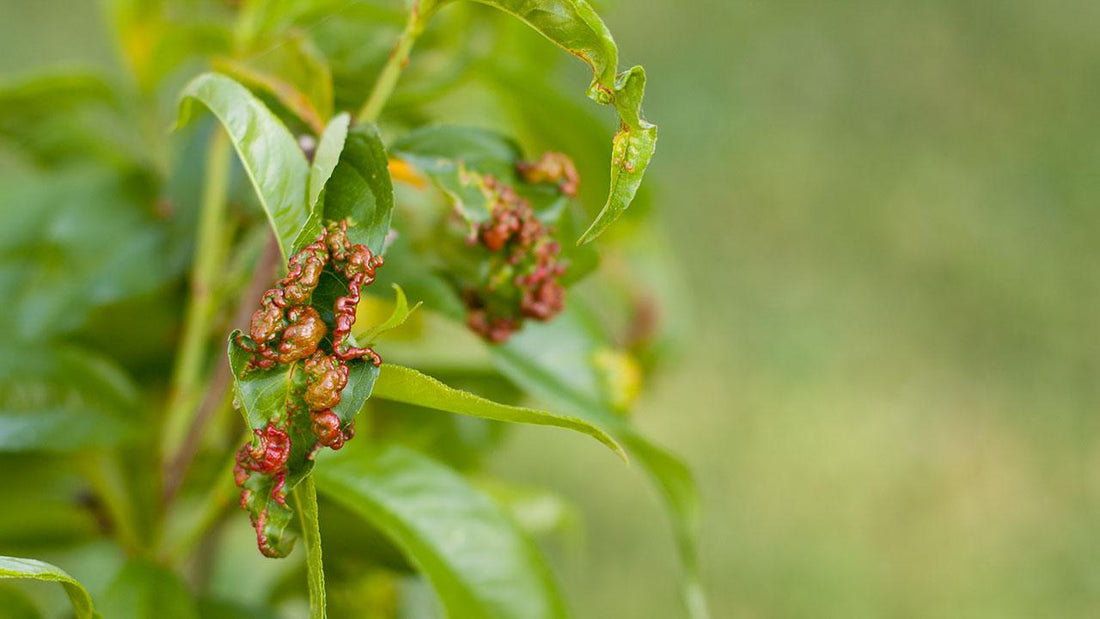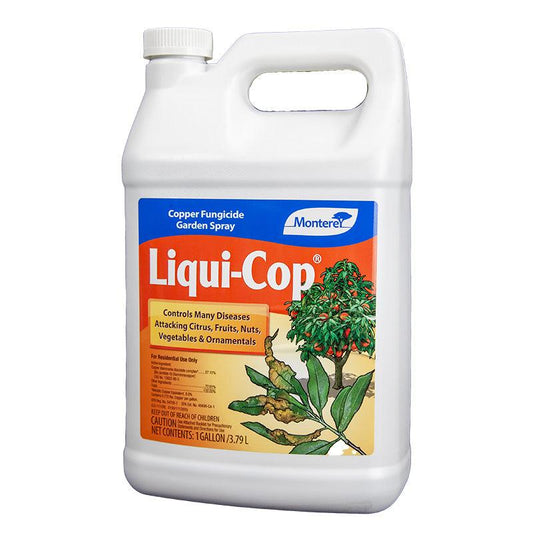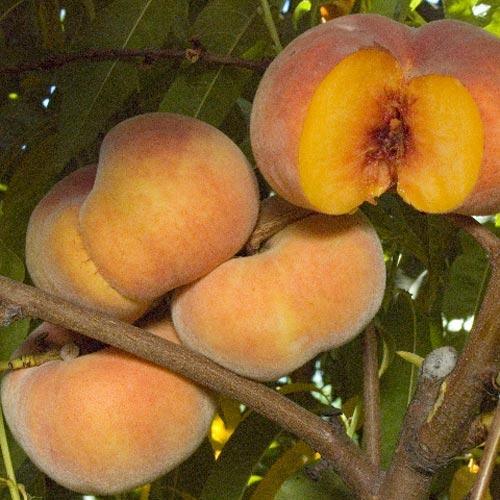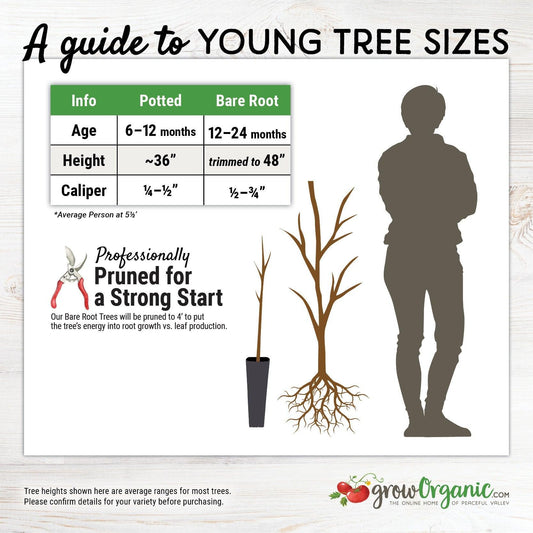Introduction to Peach Leaf Curl
What Is Peach Leaf Curl?
Peach leaf curl, also known as curly leaf, curly blight, or leaf blister, has been recognized as a common disease since the early 1800s. It is caused by the fungus Taphrina deformans and can affect the blossoms, fruit, leaves, and shoots of peaches and nectarines.
This leaf curl infection is particularly common in backyard orchards, especially during cool (48-68°F) wet weather when leaves are first opening. Infected leaves can distort and weaken the tree, affecting overall health. To help manage peach leaf curl on your fruit trees, proper care such as thinning fruit and removing affected parts is essential. Watch our video on Peach Leaf Curl where Tricia shows how to care for your trees, including tips for managing leaf curl on your nectarine tree.
Understanding the Disease: Taphrina deformans
Taphrina deformans is a fungal disease responsible for peach leaf curl, which affects peach and nectarine trees. This disease causes distorted, curled leaves, and can lead to leaf drop, reducing fruit production and overall tree health.
Managing peach leaf curl involves applying copper fungicides like copper sulfate or Bordeaux mixture during the dormant season, before buds begin to swell. In wet spring weather, it's crucial to practice peach leaf curl control by using resistant varieties and ensuring proper fungicide treatments to protect the entire tree from this harmful infection.
The Impact of Peach Leaf Curl on Your Orchard
Peach leaf curl, caused by the fungal disease Taphrina deformans, can have a severe impact on your orchard, particularly affecting peach and nectarine trees. The disease leads to distorted and discolored leaves, often resulting in leaf drop, which can significantly reduce fruit production.
Controlling peach leaf curl is crucial for the health of your peach trees, especially during wet spring weather when the fungus thrives. Implementing peach leaf curl control methods, such as applying copper fungicides like copper sulfate during the dormant season, helps protect your trees from infection and ensures a healthy, productive orchard.

Recognizing the Symptoms of Peach Leaf Curl
Early Signs of Infection
Recognizing the symptoms of peach leaf curl is crucial for effective peach leaf curl control, especially when managing peach leaf curl infections on your peach tree.
Early signs include leaf discoloration and distortion, where infected leaves may appear curled and develop abnormal textures, becoming thick and velvety. Additionally, peach trees affected by leaf curl infection often exhibit leaf drop and an overall decrease in fruit production.
To prevent and control peach leaf curl, using treatments like copper sprays and managing wet weather conditions can help protect your peach and nectarine trees from this fungal disease.

Advanced Symptoms and Damage
Recognizing advanced symptoms of peach leaf curl is essential for effective peach leaf curl control. Infected peach trees may show significant fruit and twig deformation, with fruits becoming misshapen and twigs exhibiting unusual growth patterns.
Premature leaf drop and extensive defoliation are also common, leading to reduced fruit production and weakened trees. Managing peach leaf curl involves timely treatments such as copper sprays and addressing wet weather conditions to minimize damage and help your peach and nectarine trees recover.
Differentiating Peach Leaf Curl from Other Diseases
Differentiating peach leaf curl from other diseases is crucial for effective peach leaf curl control. Peach leaf curl, caused by the fungus Taphrina deformans, typically manifests as distorted, thickened leaves with a reddish to yellowish discoloration, often leading to premature leaf drop.
In contrast, other diseases like bacterial spot or powdery mildew present with different symptoms such as leaf spots or a white powdery coating.
Managing peach leaf curl involves recognizing these distinct symptoms and applying appropriate treatments like copper sprays and lime sulfur to control the infection and protect your peach and nectarine trees.

Life Cycle of the Fungus
Symptoms appear after leaves emerge and begin to grow. The fungus causes cells in the infected portions of the leaves to grow abnormally large, causing the distorted look to the leaves. The fungus eventually produces reproductive bodies called asci that contain the spores. You will see a velvety-like appearance to the leaves, this is caused from the spores or ascospores. They are released into the air and infect other parts of the tree or other trees. In the newly infected areas the fungus continues to multiply and "cover" the tree and remain dormant in the bark and around the buds. The following spring the fungus is moved by rain or irrigation and infects new leaves. And the cycle continues. If not treated, the infection can weaken the tree and cause a decline in fruit production.
Conditions Favoring Peach Leaf Curl
Climate and Weather Influence
Conditions favoring peach leaf curl are heavily influenced by climate and weather, which play a critical role in managing peach leaf curl infections. Wet weather, especially during the dormant season and early spring, creates an ideal environment for the fungal disease Taphrina deformans to thrive, leading to increased leaf curl and other symptoms on peach and nectarine trees.
Additionally, mild winters and prolonged periods of high humidity can exacerbate the spread of peach leaf curl, affecting the overall health and fruit production of your peach trees. To control peach leaf curl and minimize damage, employing copper fungicides and ensuring proper management of these climatic conditions is essential.

The Role of Humidity and Moisture
Conditions favoring peach leaf curl are significantly influenced by humidity and moisture levels. High humidity and wet weather create a conducive environment for the leaf curl fungus, Taphrina deformans, leading to the proliferation of fungal spores and increased peach leaf curl symptoms.
Moist conditions during the dormant season and early spring can exacerbate the infection, affecting the health of peach and nectarine trees, causing leaf drop, and diminishing fruit production.
To control peach leaf curl, applying copper products such as copper soap or copper ammonium complex and managing moisture levels are crucial steps in protecting your fruit trees and ensuring their recovery.
Susceptibility Based on Geographic Location
Geographic location plays a significant role in the susceptibility of peach leaf curl, with varying climates affecting the severity of the infection. Areas with frequent wet weather and high humidity are more prone to outbreaks of the leaf curl fungus, Taphrina deformans, which thrives in these moist conditions and exacerbates peach leaf curl symptoms.
Conversely, regions with dry weather may experience fewer issues but can still see problems if the fungus overwinters or if certain peach varieties are less resistant.
In any location, employing preventative measures like copper products, including copper soap and basic copper sulfate, is essential for managing peach leaf curl and maintaining the health of your peach and nectarine trees.

Treatment for Peach Leaf Curl
Chemical controls
Copper
Products available to the home orchardist are those with lower Metallic Copper Equivalent (MCE) of about 8%, such as Liqui-Cop. Effectiveness can be improved with a sticker such as Horticultural Oils. Follow the instructions for all products and make sure you use appropriate safety equipment during application. Apply fungicide to point of runoff and a good rule of thumb is to apply three times during the dormant season: after leaf drop (around Thanksgiving), winter (around Jan.1) and before bud swell (around Feb, depending on where you live). You can apply less often if the infection the previous year was light.
Lime Sulfur
Effective for controlling peach leaf curl but not registered for sale for the backyard orchard and not available for sale in many states.
Cultural Controls
Once the tree is infected there is not much to be done to get rid of the disease that season. But it is very important to maintain the vigor of the tree throughout the active growing season. 
- Thin the fruit to reduce the demand on the trees' resources. For peaches and nectarine, thin fruit to at least 3 inches apart. Remove diseased or cracked fruit and place in the trash, not your compost pile.
- Fertilize with nitrogen by mid-June, a good balanced fruit tree fertilizer is a good choice.
- Keep watered to reduce water stress.
- Clean up dropped leaves or fruit around the base of the tree to reduce spreading to other trees. Don't put these in the compost pile, the spores can remain dormant for some time.
Another option, especially if you have to remove a weakened tree, is to consider putting in resistant or partially resistant varieties such as Frost, Indian Free, Muir, or a multigraft peach tree that contains all those varieties. If you don't care for these varieties, choose a tree that blooms later in the season. You may see less disease developing in these due to the later bloom time.
Don't let peach leaf curl ruin your favorite peach or nectarine. Yearly spraying with a fungicide listed for peach leaf curl will keep the disease in check and allow for a healthy tree and a bountiful harvest.

Conclusion
Effectively managing peach leaf curl is crucial for maintaining the health and productivity of your peach and nectarine trees. Recognizing early symptoms and understanding the disease's life cycle are essential for timely intervention.
Employing preventative strategies such as selecting resistant peach varieties and applying copper fungicides during the dormant season can significantly reduce the impact of the fungus Taphrina deformans. Additionally, proper cultural practices like pruning infected branches, thinning fruit, and maintaining tree vigor are vital for managing peach leaf curl throughout the growing season. It's important to plant your trees in well-drained soil, and ensure that fallen, infected leaves are promptly removed from the ground to prevent the spread of the disease. During the purple bud stage, copper sprays can be applied to help treat the disease before it spreads to the new leaves.
By combining these methods, you can safeguard your orchard against this common disease and ensure a fruitful harvest year after year. For quality peach trees to start your orchard, explore our selection of Bare Root Peach Trees available for sale. For further guidance and resources, consider consulting expert advice from UC IPM and Cornell University to optimize your peach leaf curl control efforts.

FAQs About Peach Leaf Curl Control
-
Q1: What are the common symptoms of peach leaf curl?
-
A: Peach leaf curl symptoms include distorted, thickened, and discolored leaves that may eventually lead to leaf fall. The affected leaves often display a reddish or grayish-white color due to the presence of the leaf curl fungus.
-
-
Q2: How can I treat peach leaf curl on my peach tree?
-
A: Treating peach leaf curl involves applying copper products, such as copper soap, copper ammonium complex products, or basic copper sulfate, during the dormant season. Bordeaux mixture and hydrated lime are also effective in controlling the disease.
-
-
Q3: Are there any peach varieties resistant to leaf curl?
-
A: Yes, a few peach varieties, such as Indian Free, are leaf curl resistant. Choosing resistant varieties for your orchard can help minimize the risk of infection.
-
-
Q4: How can I prevent the spread of peach leaf curl in my orchard?
-
A: Preventing peach leaf curl involves removing and disposing of diseased leaves and infected shoots. Using copper sprays like copper oxychloride sulfate or fixed copper products can help control the fungal spores before they infect the tree. Regular thinning of fruit and proper orchard management also contribute to healthier peach and nectarine trees.
-
-
Q5: What should I do if my peach tree is already infected?
-
A: If your peach tree is already infected with peach leaf curl, focus on applying fungicides like synthetic fungicide chlorothalonil or Monterey Lawn copper octanoate to prevent further damage. Additionally, ensure proper care to help the tree recover, including removing infected leaves and promoting the growth of healthy leaves.
-
-
Q6: When is the best time to spray for peach leaf curl?
-
A: The best time to spray for peach leaf curl is during late winter and early spring, before the buds swell. Applying copper products at this time helps prevent the fungus from infecting new leaves once they emerge. Early treatment ensures that your tree is protected before new leaves develop in spring.
-
-
Q7: Can I control peach leaf curl organically?
-
A: Yes, you can control peach leaf curl using organic products. Copper-based fungicides, like copper sulfate or copper oxychloride, are effective organic options for treating peach leaf curl. Make sure to spray trees thoroughly during the dormant season, particularly on the branches and bud scales, to prevent the disease from taking hold.
-
-
Q8: Does peach leaf curl affect nectarines?
-
A: Yes, nectarines are also susceptible to peach leaf curl, as the disease affects both peaches and nectarines in similar ways. If you grow nectarines in your garden, be sure to follow the same prevention and treatment practices as you would for peach trees, including regular spraying and pruning of infected areas.
-
-
Q9: What is the best way to protect my peach trees from frost while treating peach leaf curl?
-
A: Protecting your peach tree from frost during the early spring can help avoid further stress on the tree, especially when it is treated for peach leaf curl. Consider covering your trees with frost cloth or using other protective measures to keep the buds and flowers safe from cool temperatures. This will ensure that the tree is able to recover and grow properly after the leaf curl infection is treated.
-
-
Q10: Can peach leaf curl affect my peach tree's flowers?
-
A: Yes, peach leaf curl can also affect the flowers of your peach tree. Infected blossoms may not develop properly, leading to reduced fruit production. Early treatment and proper care, including spraying and pruning, can help protect both flowers and leaves from infection.
-
-
Q11: How should I care for my peach tree during the summer to prevent peach leaf curl?
-
A: During the summer, ensure your peach tree is healthy by providing adequate water, pruning dead or infected branches, and removing fallen leaves. Although peach leaf curl is most active in the cool seasons, regular care and monitoring during the growing season can help prevent the fungus from weakening the tree.
-
-
Q12: What are the risks of not treating peach leaf curl?
-
A: If left untreated, peach leaf curl can severely damage your tree's health, causing leaf loss, reduced fruit production, and even death of branches. Infected trees will produce fewer fruits, and those that do appear may be smaller and less flavorful. Taking action early, especially during late winter and early spring, is crucial for a healthy crop.
-
Peach Leaf Curl Management Resources 🍑
If you're growing peaches or nectarines in your garden, it's crucial to manage Peach Leaf Curl effectively to ensure healthy trees and a bountiful harvest. Below are expert resources to help you understand, treat, and prevent peach leaf curl, while also maintaining the health of your peach trees.
- 📘 Comprehensive Guide to Planting Peach Trees
- This detailed guide walks you through the step-by-step process of planting peach trees, including tips on how to create the best environment for them to thrive and avoid diseases like peach leaf curl.
- 🌱 How to Keep Ants from Eating Your Peaches
Ants can cause damage to your peach trees, and they can also be a vector for diseases like peach leaf curl. Learn effective methods to prevent ants from feasting on your peaches and protect your trees. - 💧 Watering Tips for Newly Planted Peach Trees
Proper watering is essential for the health of your peach trees. This article offers guidance on how often and how much to water your newly planted trees to ensure they grow strong and resist diseases. - 🌞 Best Peach Varieties for Zone 9
If you're growing peaches in Zone 9, this resource is perfect for selecting the best peach varieties that are more resistant to diseases, including peach leaf curl. - 🍑 When Are Peaches in Season?
Learn when peaches are in season and how that affects their susceptibility to peach leaf curl. This resource will help you plan your orchard care and harvest for the best results. - 🍽️ Fertilizing Peach Trees for Healthy Growth
This article provides expert advice on fertilizing peach trees to ensure their health and maximize fruit production. Proper nutrition is crucial in preventing diseases like peach leaf curl. - 🌿 Bare Root Peach Trees for Your Orchard
Browse our selection of bare root peach trees, perfect for starting or expanding your orchard. Our high-quality trees are ideal for managing diseases like peach leaf curl and ensuring a healthy, productive harvest.
By using these resources, you can effectively prevent and manage peach leaf curl in your orchard. Combine preventative measures, such as copper fungicides and selecting resistant varieties, with good cultural practices like thinning fruit, proper watering, and maintaining tree vigor throughout the growing season. Consider starting your orchard with high-quality bare root peach trees to ensure long-term success.
For further expert guidance, consult UC IPM and Cornell University for more in-depth tips on managing peach leaf curl and other common peach diseases.
Happy gardening and good luck with your peach trees! 🍑🌱





14 comments
Dan, you can remove the leaves that are affected by the curl and put them in the trash (not your compost pile). If you use pruners to remove the leaves, make sure that you disinfect the pruners. You don’t want to transfer anything to the healthy tree. I would not destroy the tree, just treat them next winter, clean up any leaves around the trees, don’t handle the diseased tree, then handle the healthy tree.
Thanks for your suggestions about peach leaf curl. One you didn’t mention for the backyard gardener, which has worked well for me, is to simply pinch off any sign of curl on the leaves as it first appears. I sometimes pinch off the affected parts only, leaving the remainder of the leaves, and sometimes pinch or cut off whole leaves and new shoots obviously stricken. As I work my way around the tree, I put the infected growth in a paper sack, which then goes into my woodstove to prevent further contamination.
This pruning lets the tree continue to grow normally and eventually overwhelm the fungus for the season, as conditions dry. I have had great crops of peaches using this method for more than ten years. The fungus generally has returned the following years, since I live near the coast along a wetlands in central California (ideal fungal conditions, I would say), but does seem to be diminishing.
I have a young peach tree seedling, about 2-3’ tall that I grew from a pit/seed and does not yet bear fruit. It has this leaf curl problem. Is there someway to treat the leaves and tree now instead of waiting until fall/winter or next spring?. It pains me to see it struggling and not being able to do something!
M, well the infected leave will eventually fall off and you should clean up all of the dead leaves. Put it in your trash and not your compost pile. You can make sure that your tree has sufficient nutrients to recover from losing the leaves. So add some fruit tree fertilizer. Some people like to spray their trees with compost tea as well as fertilizing. All will help the tree be as strong as it can be to recover from the disease.